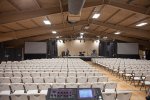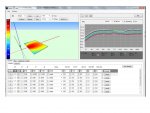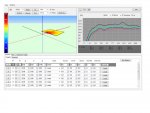I've now got a number of shows on my JBL 4886/4883/Danley TH118 system, and would love to have my observations and theories vetted and/or corrected about show setup and how to compensate for the calculator. I'm using LAC 1.29, which is the latest version. Here's a picture of a typical gig for me:

I normally run the array so the bottom is 10'-12' from the floor. I'm usually throwing between 60' and 90' from the array, sometimes flat floors, sometimes with a rake.
Here's the LAC settings I ended up with for the above show. Note the nice, parallel lines and, theoretically, fairly consistent tonality.

In use, the system sounded pretty good in the front to the middle of the room, but noticeably dark on the FOH riser. I don't have Smaart or the like, but the system has been time-aligned by a friend, and I use the RTA on my GLD surface for frequency-domain measurement.
I suspect the issue is that LAC doesn't consider the room in its calculations, and that it may be fairly accurate for outdoors, but indoors some correction may be necessary. Subjectively it seems that 500Hz and down experiences fairly significant room gain. Here is another LAC plot, this time with a fourth box per side. I suspect this plot would work better in the room, and that the gray and cyan lines would actually look more like the magenta or green lines from 500Hz down, giving more even tonality over the coverage area.

Another anomaly - if I use the EQ filter in the calculator on the bottom box to tone down the HF boost in the front of the room, the whole array moves down - apparently there is a bug in the calculator, and/or I'm doing something dumb wrong.
Am I on the right track?
Thanks for any insight.

I normally run the array so the bottom is 10'-12' from the floor. I'm usually throwing between 60' and 90' from the array, sometimes flat floors, sometimes with a rake.
Here's the LAC settings I ended up with for the above show. Note the nice, parallel lines and, theoretically, fairly consistent tonality.

In use, the system sounded pretty good in the front to the middle of the room, but noticeably dark on the FOH riser. I don't have Smaart or the like, but the system has been time-aligned by a friend, and I use the RTA on my GLD surface for frequency-domain measurement.
I suspect the issue is that LAC doesn't consider the room in its calculations, and that it may be fairly accurate for outdoors, but indoors some correction may be necessary. Subjectively it seems that 500Hz and down experiences fairly significant room gain. Here is another LAC plot, this time with a fourth box per side. I suspect this plot would work better in the room, and that the gray and cyan lines would actually look more like the magenta or green lines from 500Hz down, giving more even tonality over the coverage area.

Another anomaly - if I use the EQ filter in the calculator on the bottom box to tone down the HF boost in the front of the room, the whole array moves down - apparently there is a bug in the calculator, and/or I'm doing something dumb wrong.
Am I on the right track?
Thanks for any insight.
Last edited:



